Oriental Whip Snake
The oriental whip snake is a very common rear-fanged venomous snake found here in Thailand’s rain forests. You can find these snakes in the trees during the day, I have even seen them crossing my path twice on trips up a small local mountain in southern Thailand.
The beauty of these snakes is legendary. There are green, yellow, or grey phases of this snake, all of which are spellbindingly beautiful. The juvenile whip snakes are often brown or yellow.
Ahaetulla prasina (Oriental Whip snakes)
Thai Language: ngoo kee-ow hoo-uh jing joke pa
Length: Up to 190 cm. Girth: The body is finger thin, tapering to a very thin pencil-width neck. The head is spear-shaped and bright green.
Range: All over Thailand. The species ranges from India to China and throughout Southeast Asia.
Habitat: During the day you can find these snakes in trees and bushes usually. Occasionally they will be at ground level hunting frogs and small lizards. I have seen these snakes in all kinds of habitats, but usually in trees and leafy bushes. At night these snakes sleep in the same environment.
Active Time? Diurnal – active during the daylight hours.
Food: Frogs, small birds, small lizards.
Defensive Behavior: The oriental whip snake can spread its neck area to increase by double in size as a defensive technique designed to scare attackers. It is quite beautiful when either solid green or with the green, white and black checkered pattern displayed in full defensive posture. Sort of comical is what the snake does with its tongue when molested. It sticks the tongue out and holds it there for some seconds, or minutes.
Venom Toxicity: Weak. Although this is considered to be a rear-fanged and venomous snake it is not very dangerous to humans due to its non-aggressive nature and weak venom characteristics. The venom would need to be injected into the wound with time – with a chewing motion. Not many people bitten are going to let a snake hang off them for any amount of time. Some do, and they may have severe complications and require hospitalization.
Offspring: In Thailand, the Ahaetulla prasina can mate during either of two times. Usually between April and July, and then also between December and January. Gestation period: ~ 6 months. Number of births: 4-10. Lengths at birth of offspring: 400 – 500 mm.
Notes: These are wonderful little snakes to catch and let go. These snakes do not do well in captivity and many die within days of being kept in an enclosure. They are as beautiful as snakes get, but please resist the urge to capture one to keep as they are very sensitive and die easily.
We have not been bitten by these snakes, but in the wild when catching them they will attempt to strike at times. They are fast and have a short striking range. What is really amazing about these snakes is the way they effortlessly glide down a hill or through trees like on ice. They can climb extremely fast and disappear before you have a chance to grab them. See the video below!
These snakes are not often confused with other snakes here in Thailand because they are quite distinctive. Their head is long and to a fine point. They are very thin at the neck before the head unless they have flared up in defense.
Ahaetulla prasina
Oriental Whipsnake (Ahaetulla prasina)
Scientific classification
Kingdom: Animalia
Phylum: Chordata
Class: Reptilia
Order: Squamata
Suborder: Serpentes
Family: Colubridae
Subfamily: Colubrinae
Genus: Ahaetulla
Species: Ahaetulla prasina
Binomial name: Ahaetulla prasina
(Classified by Shaw, in the year 1802)
Photo of a brown-hued Ahaetulla prasina shot by Tom Charlton – shown here with permission:
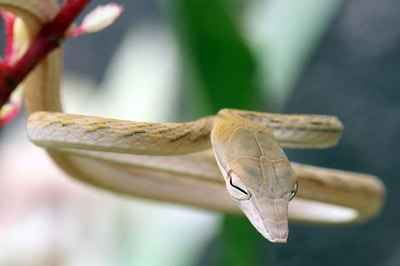
Photo of an Ahaetula prasina.
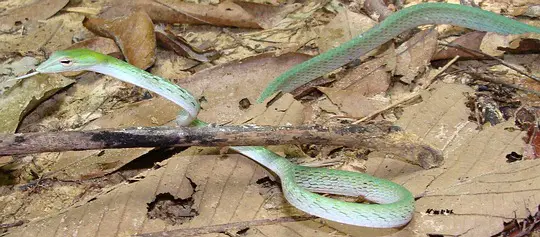
Oriental Whip Snake Videos:

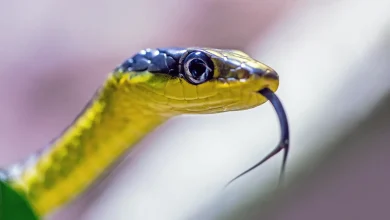
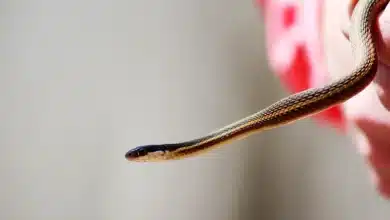
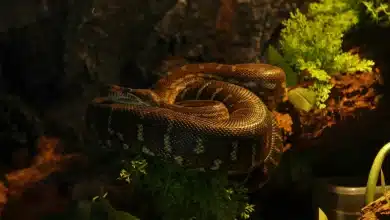
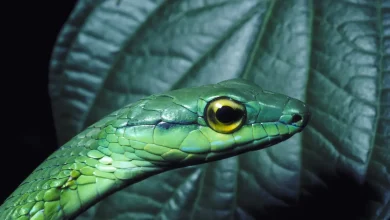
Looking at these snakes… I think maybe I’m calling the Malayan Whip Snake – the Oriental Whip Snake! Will have to revise the images on this page to match Ahaetulla prasina!
My wife and I are on holiday in Thailand right now. As we got up from our sunloungers to go inside, I heard a ‘thwap’ and suddenly there was a snake behind me (presumably it had fallen out of the tree). It promptly slithered away before any cameras could be brought to bear, but having checked your excellent blog, it seems certain we encountered Ahaetulla Prasina.
Thanks for providing this resource!
No problem Misha! Thanks for taking the time to thank me for it. I really hope a lot more people are helped than write comments about it! Cheers man!
Saw one today on Koh Lanta island, slithering slowly along some bush branches. Beautiful bright green, a great climber. Lovely pointy nose. Thanks for your information on this amazing creature.
Just moved to Phetchabun. Saw one today as I was off walking to get some ice.
It was just casually tooling across the road, seemingly oblivious to my presence. A beautiful, thin, green snake about 70cm long. Ring-finger thick.
It kept going into the culvert and disappeared. Thanks for helping me identify the beast.
Seventh trip to Thailand and my first snake sighting in the wild!
Likely either the Oriental whip snake (Ahaetulla prasina), or Golden tree snake (Chrysopelea ornata). Both are common and harmless for people.
Just saw about a 10″ green specimen in my garden. Same color and shape as the grass it was in. Super long thin head and thin neck about 3mm. No more dragging thru the grass in flip flops for me!!! Paul west of Bangkok at Inthrapat.
Sounds like Ahaetulla prasina or A. nasuta. Both harmless tree snakes that sometimes are found on the ground. They are the only snakes that fit your description.